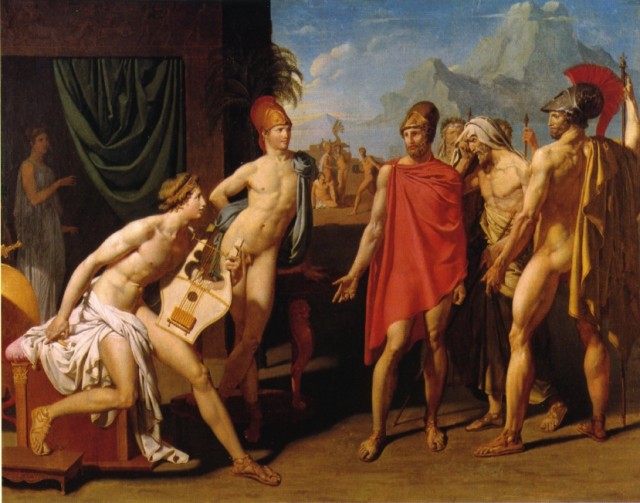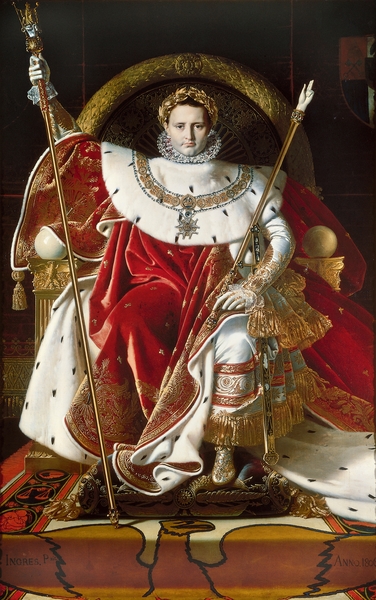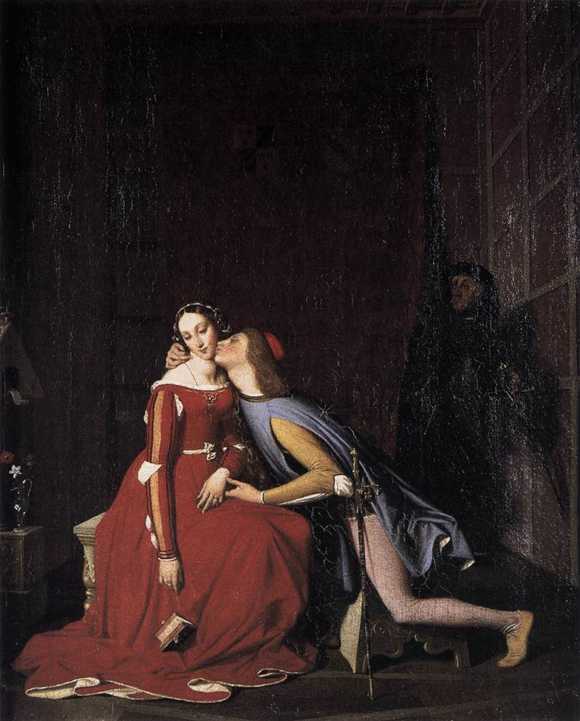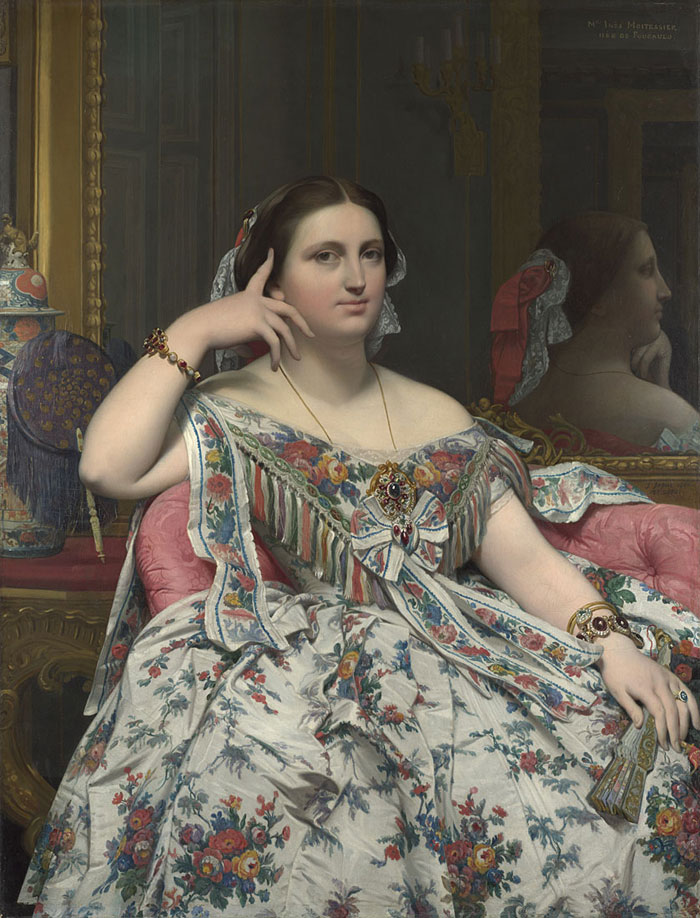Jean Auguste Dominique Ingres was born on the 29th of August 1780 in Montauban, France. His first artistic education was received through his father, Jean-Marie Joseph followed by the Fine Arts Academy in Toulouse in 1791. His artistic career escalated quickly after 1797. In the following four years, he had studied in the studio of Dalia, was accepted into the École des Beaux Art and received the award Prix de Rome for his piece The Envoys of Agamemnon (fig.1). His paintings followed the Romanesque style with its vivid emotions and imaginary settings.

Around the beginning of the 19th century, Ingres began to gain a reputation as a portraitist. His style, although still romantic is some perspective, began to reflect the Byzantines era due to harsh frontality found in his paintings. The adoption of a quality found in the Late Gothic period, labeled his art barbaric and archaic. His most criticized work being Napoleon on his Imperial Throne (1806) (fig.2). His front facing portrait, displaying little to no emotion with addition to his position emphasizing power displayed “stylistic references (…) of the past” (Napoleon, 2017). However, such work is now admired for his “uncanny control of delicate yet firm line, (his) inventiveness in posing sitters so as to reveal personality through gestures, and (his) impressive capacity to record an exact likeness”(Encyclopædia Britannica, 2019).
Ingles moved to Rome, Italy where he continued his portrait work. Even with the fall of Napoleon’s Empire, Ingles created small portraits easily sold to English tourists. Suddenly, around the 1818s, Ingles began to resent portrait work and desire to paint great historical moments. Despite his change in subjects, his paintings were still being criticized as gothic. Notably his piece Paolo and Francesca (1819) (fig.3) which displayed extreme stiffness according to the public.

Figure 2. Napoleon on the Imperial Throne, by Jean-Auguste-Dominique Ingres, 1806 
Figure 3. Paolo and Francesca (1819)
His reputation turned for better after the 1820s. Ingres has begun to be recognized as a religious painter and his style slowly geared towards an academic style – Neoclassical. He became in favor of drawing over color and committed to idealization. Paintings such as The Vow of Louis XIII (1824) (fig.4) had become sensations in France and revered as exemplary. As a result, Ingles returned to France.
By 1828, Ingles became professor at the École des Beaux-Art. As a result of imposing his own narrative on french painting, he was forced to leave in 1833. The following year, Ingles became director of the Académie de France in Rome. With ever growing popularity in France, Ingles returned once more where he was celebrated by banquets and dinners with the King.
By the 1840, Ingles had become the “greatest living artist in France”(Encyclopædia Britannica, 2019). Ingles returned to portrait, a style he had once been mocked for, due to prestigious commissions such as Mme.Inès Moitessier (fig.5). He later died in 1867 in Montauban.

Work Cited.
Figure 1
“The Ambassadors of Agamemnon in the Tent of Achilles.” Wikipedia, Wikimedia Foundation, 14 July 2019, en.wikipedia.org/wiki/The_Ambassadors_of_Agamemnon_in_the_tent_of_Achilles#/media/File:The_Envoys_of_Agamemnon_by_Ingres.jpg.
Figure 2
“Napoleon on the Imperial Throne, by Jean-Auguste-Dominique Ingres, 1806, oil on canvas.” Bridgeman Images: DeAgostini Library, edited by Bridgeman Images, 1st edition, 2014. Credo Reference, https://ezproxy.capilanou.ca/login?url=https://search.credoreference.com/content/entry/bridgemandeag/napoleon_on_the_imperial_throne_by_jean_auguste_dominique_ingres_1806_oil_on_canvas/0?institutionId=6884. Accessed 03 Oct. 2019.
Figure 3
Blog-Senirupa. “Jean Auguste Dominique Ingres.” Seni Rupa, 18 Feb. 2013, blog-senirupa.tumblr.com/post/43395248778/jean-auguste-dominique-ingres.
Figure 4
“The Vow of Louis XIII.” Wikipedia, Wikimedia Foundation, 25 Apr. 2019, en.wikipedia.org/wiki/The_Vow_of_Louis_XIII#/media/File:Le_Voeu_de_Louis_XIII.jpg.
Figure 5
“Madame Moitessier.” National Gallery Collection, National Gallery, The National Gallery, 1st edition, 2009. Credo Reference, https://ezproxy.capilanou.ca/login?url=https://search.credoreference.com/content/entry/ng/madame_moitessier/0?institutionId=6884. Accessed 03 Oct. 2019.
Websites:
“Ingres, Jean Auguste Dominique.” The Columbia Encyclopedia, Paul Lagasse, and Columbia University, Columbia University Press, 8th edition, 2018. Credo Reference, https://ezproxy.capilanou.ca/login?url=https://search.credoreference.com/content/topic/ingres_jean_1780_1867?institutionId=6884. Accessed 03 Oct. 2019.
“Ingres Paintings, Bio, Ideas.” The Art Story, www.theartstory.org/artist/ingres-jean-auguste-dominique/.
Shelton, Andrew Carrington. “J.-A.-D. Ingres.” Encyclopædia Britannica, Encyclopædia Britannica, Inc., 25 Aug. 2019, www.britannica.com/biography/J-A-D-Ingres.
Young, Rebecca. “Napoleon I on His Imperial Throne.” Napoleon.org, Jan. 2017, www.napoleon.org/en/history-of-the-two-empires/paintings/napoleon-i-on-his-imperial-throne/.
